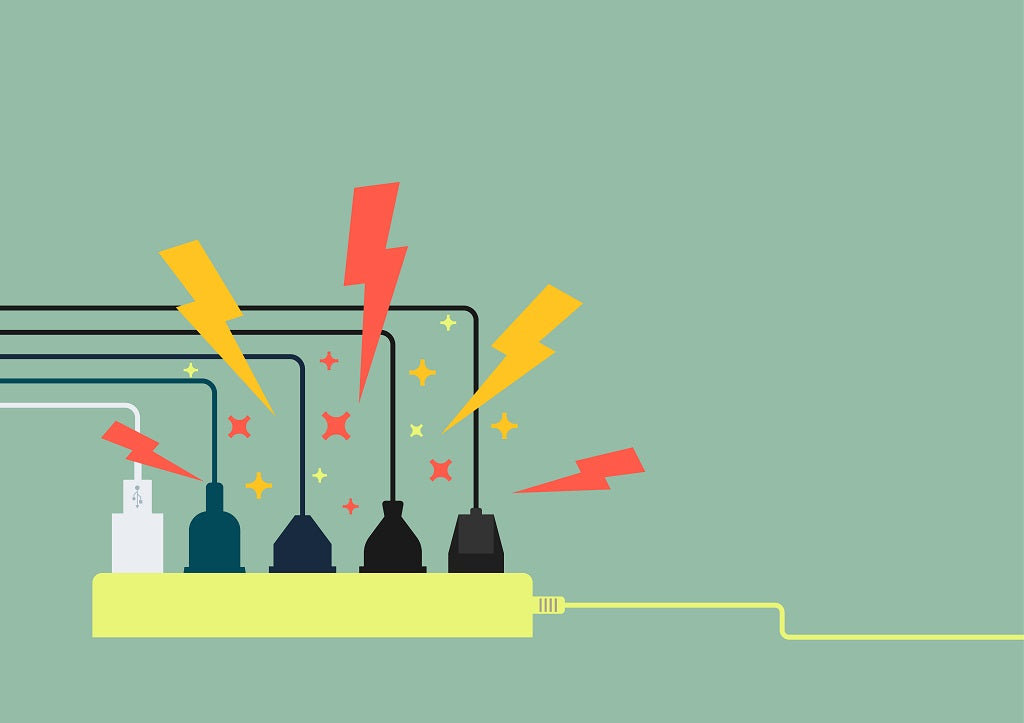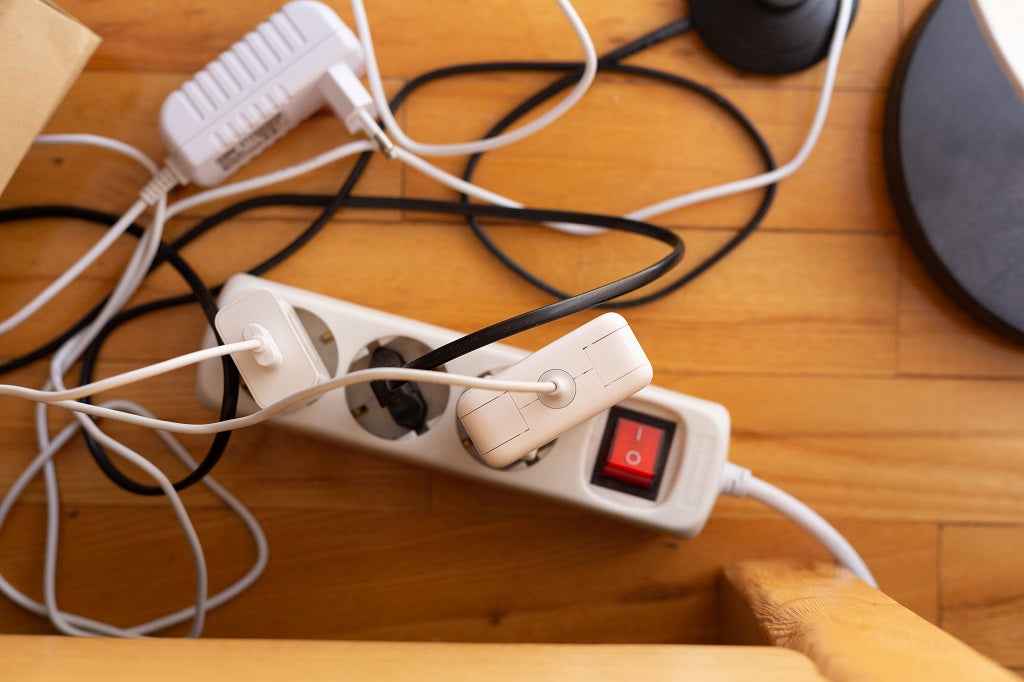
Electricity has become our new way of life; we can’t really function or even perform daily routine tasks anymore without the help of electricity. It has become an essential commodity. However, as useful as it is when there is a surge in our home and our system crashes it can cause damage to our devices.
In this article, we’ll tell you about power surge meaning, what causes power surges in your home, how to protect your house from power surges, and more!
What Is a Power Surge?
A power surge (also known as transient voltage) means an unexpected increase in voltage. Power surges can be caused by many factors; when a power grid is being switched, thunderstorms, and when large home appliances flicker on and off.
How long does a power surge last? Power surges can last for hours, and they can also only last seconds. The length of time is irrelevant for the damage may be devastating regardless.
How Do Power Surges Happen?

Power surges occur when electrical power is above the allotted amount. There are many ways power surges can happen; when there is a sudden interruption of the electrical flow or when an increase of voltage is sent through the electrical system this could be related to internal or external issues or when power is interrupted and sent flowing back into the system.
Power surges ultimately lead to power outages and blackouts. There are many reasons why this could happen: a thunderstorm when lightning strikes power lines, electrical power overload when too many appliances are plugged in together, faulty wiring which is a problem in many homes especially the older ones.
How Do Power Surges Cause Damage?
There is a misconception that electricity comes to our devices in the form of a steady stream when in fact the current comes to us in an alternating current. The alternating current makes the voltage rise and fall in a rhythmical way, however when the rhythm is offset by any factors a surge will be inevitable. This leads to a dramatic increase in voltage, and it is this uptick that can harm our appliances and devices.
So how does a power surge damage electronics? There is a misconception that electricity comes to our devices in the form of a steady stream when in fact the current comes to us in an alternating current. The alternating current makes the voltage rise and fall in a rhythmical way, however when the rhythm is offset by any factors a surge will be inevitable. This leads to a dramatic increase in voltage, and it is this uptick that can harm our appliances and devices.
Most appliances and electrical devices come equipped with an operating voltage. When a surge happens it can release heat and it is this heat that will damage electronic circuit boards and other electrical parts in the house. Most appliances and electrical devices come equipped with an operating voltage. When a surge happens it can release heat and it is this heat that will damage electronic circuit boards and other electrical parts in the house.
How Often Do Power Surges Occur?
How common are power surges? Unfortunately, power surges are not a rare occurrence. The level of a surge may vary. Smaller surges are frequent, and they can over time cause appliances and devices to stop working altogether. The standard voltage for America is 120V, a surge can happen if the voltage exceeds anywhere from 121V to 169V, once the voltage reaches 170V that is when the surge is especially harmful.
What Causes Power Surges?

There are many reasons for power surges to occur, mainly bad wiring, lightning, blackouts, and electrical overload.
Electrical Overload
Electric overloads happen when too much current passes through the electricity wires. The heat then melts the wires and it can cause an electrical fire. Electrical overloads are caused by too many appliances plugged into the same plug or exaggerated use of extension cords; multiple plugs and adaptors can overburden an electrical circuit.
Faulty Wiring
Faulty wiring can be detected in advance. If you see that a lot of your electrical outlets and switches are charred there is a high chance that your wiring is the culprit. In addition, if you encounter many instances of flickering lights, unexpected dimming of lights, fuses and randomly blowing out then you may have a severe issue with defective wiring.
Lightning Strikes
Can lightning cause a power surge? Lightning bolts are pure energy, and they are fuelled by electricity, when lightning strikes near a powerline, it is guaranteed to cause an electrical surge. Lightning bolts can boost electrical pressure on a grid by millions of volts, this makes protecting our devices and grid from lightning a Herculean effort.
Power Outage or Blackout
A power outage will cause a blackout, when this happens, all unsaved data on electronic devices will be lost. This is a tragedy but not the most harmful aspect of a power outage. The real damage can occur when the power is turned on and like a tsunami of electrical energy all appliances and devices come roaring back to life. That is when an overload will happen, and this can harm all appliances left turned on.
Power Grid Switching
When an electric utility company experiences an issue at their home base such as technical failure at the power stations, damage to electric power lines, human error that is when a power surge can also happen. This can cause problems with the short circuit, fuse or breakers, and other electrical issues that can be devastating to our appliances and plugged-in electronics.
What Are The Signs of a Power Surge?

It is essential to monitor our electricity and our appliances at home to avoid endangering ourselves or harming other household appliances. There are many signs that can indicate that a power surge occurred:
- The plugged-in device, lights, and clocks are flashing throughout the house.
- An appliance is off and can’t be turned back on again.
- There is a lingering, unpleasant smell of smoke or burnt cables in the air.
What to Do After a Power Surge?
Power surges are inevitable, and we must learn to live through them, they are inconvenient but not often dangerous. Of course, certain steps need to be followed once the power comes back up to minimize the damage to our appliances and devices:
- Unplug and rest your devices.
- Repower all electronic devices if needed.
- Turn on all appliances that haven’t been turned on by themselves.
- Inspect electric outlets, breaker boxes, and appliances.
- Check your HVAC system to ensure that the cooling and heating system is intact.
How to Protect Your Appliances From Power Surges

How to protect your home from power surges? Knowledge is power. Firstly, understand what causes your electrical surges and then invest in protection from power surges in your home.
Unplug Devices You Aren't Using
It is highly recommended that all devices and appliances that are not in use should be unplugged. This not only safeguards your appliances from harm, but it can also prevent fire hazards. In addition, doing this also can save you money by conserving energy.
Upgrade Inadequate Wiring
Over time, wires can oxidize, and then in turn the cables could create heat. If wiring is not changed or upgraded, this faulty wiring can become a fire hazard. As is, overloaded wires get hot but if the cables are faulty the damages can be devastating to you and your appliances.
Fix Overloaded Circuits
One of the great ways to prevent a circuit overload is to invest in several circuits; this may not always be a feasible option. Then there are LEDs which are becoming more and more popular and are a good idea. You must also calculate the load your circuit can withstand.
Surge Protectors
A surge protector is an invaluable tool to safeguard your appliances and prevent fires. As the name indicates they absorb the increase in power, so it minimizes or prevents your appliances or devices from receiving the surge and getting damaged in the process.
How to Choose a Right Surge Protector
Surge protectors come in many different forms and sizes, but their application is always the same. Surge protectors offer you, your appliances, your devices, and your home an extra layer of protection between the outside world and your circuit breaker. Let’s look at the different types of surge protectors:
- A whole-house surge protector: It works like a pressure valve relieving excess electrical energy from causing voltage spikes. It will be installed in the main power panel box of your home.
- Surge suppressors and power strips: This is a common one on the market. It allows you to plug in more appliances and or devices using the same plug while withstanding significant power surges. Take a look at our selection of products and find the best power strip surge protector!
- Outlet adaptor surge protector: This is a surge protector that can be plugged directly into the wall outlet.
Conclusion
They say that lightning does not strike the same place twice. I think it is wise to not test mother nature because we know that unexpected things will always happen. It is important to get informed and always be prepared to protect our home and our family. Find a product list that can help you get more perspective on the varying products from Schneider Electric, Square-D and other manufacturers available to you on blackhawksupply.com!


